Please refer to the Case Study Questions Chapter 2 Sectors of The Indian Economy with answers provided for Class 10 Social Science. These solved case study based questions are expected to come in the Class 10 Economics exam in the current academic year. We have provided Case study for Class 10 Social Science for all chapters here. You should practise these solved case studies to get more marks in examinations.
Chapter 2 Sectors of The Indian Economy Case Study Questions Class 10 Social Science
1. Read the source given below and answer the following questions:
The secondary sector covers activities in which natural products are changed into other forms through ways of manufacturing that we associate with industrial activity. It is the next step after primary. The product is not produced by nature but has to be made and therefore some process of manufacturing is essential. This could be in a factory, a workshop or at home. For example, using cotton fibre from the plant, we spin yarn and weave cloth. Using sugarcane as a raw material, we make sugar or gur. We convert earth into bricks and use bricks to make houses and buildings. Since this sector gradually became associated with the different kinds of industries that came up, it is also called as industrial sector. After primary and secondary, there is a third category of activities that falls under tertiary sector and is different from the above two. These are activities that help in the development of the primary and secondary sectors. These activities, by themselves, do not produce a good but they are an aid or a support for the production process. Transport, storage, communication, banking, trade are some examples of tertiary activities. Since these activities generate services rather than goods, the tertiary sector is also called the service sector.
Answer the following MCQs by choosing the most appropriate option.
(i) Which sector includes the units producing services?
(a) Primary sector
(b) Secondary sector
(c) Tertiary sector
(d) All the above
Answer
C
(ii) Which one of the following economic activities is not in the tertiary sector?
(a) Banking
(b) Bee keeping
(c) Teaching
(d) Working in a call centre
Answer
B
(iii) The service sector includes activities such as
(a) agriculture, dairy, fishing and forestry
(b) making sugar, gur, and bricks
(c) transport, communication and banking
(d) none of these
Answer
C
(iv) Which of the following types of activities are covered in the secondary sector?
(a) It generates services rather than goods.
(b) Natural products are changed through manufacturing.
(c) Goods are produced by exploiting natural resources.
(d) It includes agriculture, forestry and dairy.
Answer
B
2. Read the source given below and answer the questions that follows:
The value of final goods and services produced in each sector during a particular year provides the total production of the sector for that year. And the sum of production in the three sectors gives what is called the Gross Domestic Product (GDP) of a country. It is the value of all final goods and services produced within a country during a particular year. GDP shows how big the economy is. In India, the mammoth task of measuring GDP is undertaken by a central government ministry. This Ministry, with the help of various government departments of all the Indian states and union territories, collects information relating to total volume of goods and services and their prices and then estimates the GDP. After primary and secondary, there is a third category of activities that falls under tertiary sector and is different from the above two. These are activities that help in the development of the primary and secondary sectors. These activities, by themselves, do not produce a good but they are an aid or a support for the production process. For example, goods that are produced in the primary or secondary sector would need to be transported by trucks or trains and then sold in wholesale and retail shops. At times, it may be necessary to store these in godowns. We also may need to talk to others over telephone or send letters (communication) or borrow money from banks (banking) to help production and trade. Transport, storage, communication, banking, trade are some examples of tertiary activities. Since these activities generate services rather than goods, the tertiary sector is also called the service sector.
Answer the following MCQs by choosing the most appropriate option.
(i) The money value of all final goods and services produced within a country during a particular year is called:
(a) Gross domestic product
(b) Net domestic product
(c) National product
(d) Production of secondary sector
Answer
A
(ii) Life insurance is an activity of the
(a) primary sector
(b) secondary sector
(c) service sector
(d) none of the above
Answer
C
(iii) Which sector has emerged as the largest producing sector in India. Select one from the following alternatives:
(a) Secondary sector
(b) Tertiary sector
(c) Primary sector
(d) Science and Technology sector
Answer
B
(iv) Information and communication technology is associated with
(a) primary sector
(b) secondary sector
(c) tertiary sector
(d) none of the above
Answer
C
3. Read the information given below and select the correct option:
Rahul is an agricultural labourer. There are several months in a year when he has no work and needs credit to meet his daily expenses. He depends upon his employer, the landowner for credit who charges an interest rate of 8 per cent per month. Rahul repays the money by working physically for the landowner on his farmland.
Over the years his debt will –
(a) Increase – because of increasing interest and non-payment of monthly amount
(b) Remain constant – as he is working for the employer but is repaying less
(c) Reduce – as amount equivalent to his salary is being counted as monthly repayment
(d) Be totally repaid – as he is repaying the debt in the form of physical labour
Answer
A
OR
Most of the agricultural labourers like Rahul depend upon loans from informal sector. Which of the following statements about this sector is correct?
(a) There are government bodies to supervise informal sector.
(b) Money lenders ask for a reasonable rate of interest.
(c) Cost of informal loans to the borrower is quite high.
(d) Money lenders use fair means to get their money back.
Answer
C
4. Read the source given below and answer the following questions:
The organised sector offers jobs that are the most sought-after. But the employment opportunities in the organised sector have been expanding very slowly. It is also common to find many organised sector enterprises in the unorganised sector. They adopt such strategies to evade taxes and refuse to follow laws that protect labourers. As a result, a large number of workers are forced to enter the unorganised sector jobs, which pay a very low salary. They are often exploited and not paid a fair wage. Their earnings are low and not regular. These jobs are not secure and have no other benefits. Since the 1990s, it is also common to see a large number of workers losing their jobs in the organised sector. These workers are forced to take up jobs in the unorganised sector with low earnings. Hence, besides the need for more work, there is also a need for protection and support of the workers in the unorganised sector.
Answer the following MCQs by choosing the most appropriate option.
(i) Manufacturing units in unorganised sector are:
(a) not subject to government regulations
(b) subjects to government regulations
(c) subject to central bank’s regulations
(d) none of the above
Answer
A
(ii) Which of the following is not applicable for a worker, who works in the organised sector?
(a) She gets a regular salary at the end of the month.
(b) She is not paid for leave.
(c) She gets medical allowance.
(d) She got an appointment letter stating the terms and conditions of work when she joins work.
Answer
B
(iii) Choose the correct meaning of organised sector.
(a) It covers those enterprises where the terms of employment are regular.
(b) It is outside the control of the government.
(c) Jobs are not regular.
(d) It provides low salaries.
Answer
A
(iv) Which of the following examples does not fall under unorganized sector?
(a) A farmer irrigating his field.
(b) A daily wage labourer working for a contractor.
(c) A doctor in a hospital treating a patient.
(d) A handloom weaver working on a loom in her house.
Answer
C
5. Read the source given below and answer the questions that follows:
The product of this activity, cotton, is a natural product. Similarly, in the case of an activity like dairy, we are dependent on the biological process of the animals and availability of fodder etc. The product here, milk, also is a natural product. Similarly, minerals and ores are also natural products. When we produce a good by exploiting natural resources, it is an activity of the primary sector. Why primary? This is because it forms the base for all other products that we subsequently make. Since most of the natural products we get are from agriculture, dairy, fishing, forestry, this sector is also called agriculture and related sector. The secondary sector covers activities in which natural products are changed into other forms through ways of manufacturing that we associate with industrial activity. It is the next step after primary. The product is not produced by nature but has to be made and therefore some process of manufacturing is essential. This could be in a factory, a workshop or at home. After primary and secondary, there is a third category of activities that falls under tertiary sector and is different from the above two. These are activities that help in the development of the primary and secondary sectors. These activities, by themselves, do not produce a good but they are an aid or a support for the production process Service sector also includes some essential services that may not directly help in the production of goods. For example, we require teachers, doctors, and those who provide personal services such as washermen, barbers, cobblers, lawyers, and people to do administrative and accounting works. In recent times, certain new services based on information technology such as internet cafe, ATM booths, call centres, software companies etc have become important.
Answer the following MCQs by choosing the most appropriate option.
(i) Which sector converts raw materials into goods?
(a) primary sector
(b) secondary sector
(c) unorganised sector
(d) organised sector
Answer
B
(ii) Manufacturing sector is associated with
(a) primary sector
(b) secondary sector
(c) tertiary sector
(d) private sector
Answer
B
(iii) Production of a commodity through exploitation of natural resources is an activity in the
(a) primary sector
(b) secondary sector
(c) tertiary sector
(d) information technology sector
Answer
A
(iv) Which sector includes the units producing services?
(a) primary sector
(b) secondary sector
(c) tertiary sector
(d) all the above
Answer
C
Very Short Answer Type Questions
Question. Suggest any one way to generate employment in urban areas.
Ans. Following are the ways in which employment can be generated in urban areas:
(1) Improve local and inter city transportation.
(2) Increase vocational education courses.
Question. When was MGNREGA passed?
Ans. 2005
Question. How is GDP calculated?
Ans. GDP in India is calculated by the expenditure method. Only final goods and services are counted to get the final value.
Therefore, GDP = Value of output – Intermediate consumption.
Question. The table below shows the estimated number of workers in India in the organised and unorganised sectors. Read the table carefully and answer the question given below: What percentage of tertiary sector workers in India are employed in Unorganised Sector according to the table?
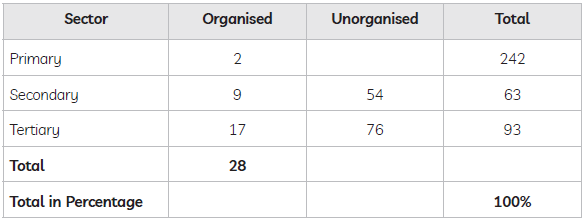
Ans. To calculate percentage of tertiary sector workers employed in unorganised sector:
= (Numberof employees in unorganised sector/Total number of employees in tertiary sector) × 100
Total number of workers in tertiary sector:
17 + 76 = 93
Percentage employed in unorganised sector:
(76/93) × 100 = 81.7%
Question. Why is the tertiary sector becoming an important sector in India? Explain the main reason.
Ans. (1) The tertiary sector helps in the development of primary and secondary sectors by transporting goods, providing loans etc. Thus, helping in the development and growth of both primary and secondary sector.
(2) The tertiary sector provides the basic services like public transportation, medical car, electricity, banking, post office etc. under the control of the government.
(3) The tertiary sector creates an huge area for employment even for uneducated and unskilled work.
(4) The tertiary sector distributes the consumer goods to different suppliers.
Question. Which category of economic sector does the activity of changing natural products into other forms come under?
Ans. Activities related to changing natural resources into other forms come under the primary sector.
Question. Look at the picture given below and identify the sector to which the characters shown in it belong to.
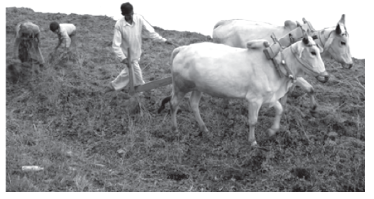
Ans. The workers shown in the picture are associated with agricultural sector also known as Primary sector.
Question. Suggest any one way to increase the income of the marginalised groups in India.
Ans. Marginal farmers need to be supported through adequate facility for timely delivery of seeds, agricultural inputs, credit, storage facilities and marketing outlets.
Question. What is GDP?
Ans. GDP is the value of final goods and services produced in each sector during a particular year.
Question. Explain the main advantage of organised sector with respect to employment.
Ans. In the organised sector, terms of employment are regular and people have assured work throughout the year.
Question. Suggest any one way to create employment in semi-rural areas.
Ans. By setting up of small and agro-based industries, employment can be created in semi-rural areas.
Question. How is public sector different from the private sector?
Ans. The public sector is owned, managed and controlled by government whereas the private sector is owned, controlled and managed by individuals or group of individuals.
Question. Study this picture. Answer the question that follows: Identify the sector to which the worker in the picture belongs ?
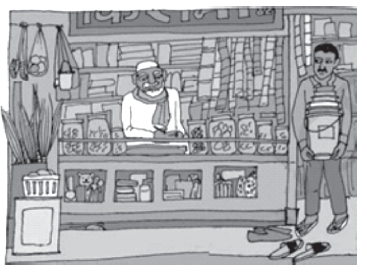
Ans. They belong to the Tertiary Sector.
Question. In a city, 5000 people work in offices and factories registered with the government, 3000 own offices, clinics in market places with formal license, 7000 people work on street, construction workers and domestic help whereas 9000 people work in small workshops usually not registered with the government. On the basis of the information given above calculate the percentage of people working in the Organised sector and choose the correct option.
(a) 20%
(b) 33%
(c) 50%
(d) 66%
Ans. (b) 33%
Question. Give one example each of primary and tertiary economic sectors.
Ans. Activities like agriculture, mining, etc. are examples of the primary sector, whereas activities like banking, tourism, etc. are examples of tertiary sector.
Question. Analyse the table given below and answer the question that follows: This source shows a database of Workers employed in different sectors (in millions) Calculate, the percentage of people in organised sector?

(a) 8.4%
(b) 9.6%
(c) 7.6%
(d) 10%
Ans. (c) 7.6%
Question. Identify what sector does these products belong to?
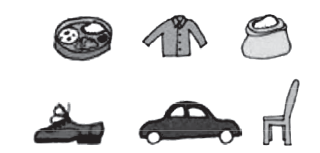
Ans. These products belong to Secondary Sector.
Short Answer Type Questions
Question. ‘‘Tertiary sector activities help in the development of the primary and secondary sectors.’’ Evaluate the statement.
Ans. ‘‘Tertiary sector activities help in the development of the primary and secondary sectors.’’ This statement can be understood by the following points :
(1) The tertiary sector does not produce any goods by itself but it supports the production process of the primary and secondary sectors.
(2) The tertiary sector comprises of several essential services such as hospitals, educational institutions, police stations, courts, transports, bank, etc. These basic services boost the primary and secondary sectors simultaneously. (3) Goods produced by the primary and secondary sectors are used by and sustained the tertiary sectors to provide services. For example, buildings created by the secondary sector are used by the tertiary sector, such as hotels, colleges, restaurants, residences etc.
Question. How can move employment be generated in the agriculture sector ? Explain any three methods.
Ans. More employment can be generated in the agriculture sector alone in the following ways:
(1) Increase in irrigation facilities: Without irrigation, only a single crop can be grown in most agricultural fields, which means less working opportunities, but if irrigation is provided, two or three crops can be grown on the same field. So more people will be employed.
(2) Provide Basic facilities: Government should provide basic infrastructure in agriculture related facilities such as transportation (building of roads), irrigation, banking to ease the work of farmers. Subsidies can be provided. Dams and storages’ can be built.
(3) Provide them easy loan: If people are provided easy bank loans, then they could start small businesses, which will make them self-dependent.
(4) Storage: Storage facilities should be provided to farmers so that they can store their produce and can be able to sell it later.
Question. How does the public sector contribute to the economic development of the nation? Explain.
Ans. The public sector contributes to the economic development of the nation in the following ways:
(1) It promotes rapid economic development through creation and expression of infrastructure.
(2) It generates financial resources for development.
(3) It ensures equality of income, wealth and thus a balanced regional development.
(4) It encourages the development of small, medium and cottage industries.
(5) It ensures easy availability of goods at moderate rates.
(6) It contributes to community development i.e., to the human development index (HDI) via health and educational services.
Question. Mention the employment conditions prevailing in the organised sector.
Ans. The employment conditions prevailing in the organised sectors are as follows:
(1) People working in the organised sectors have job security and get regular monthly salary.
(2) They get paid leaves, salary during holidays, medical facilities, provident fund, gratuity, pension after retirement etc.
(3) People working in this sector have fixed working hours.
Question. Underemployment continues to be rampant in the rural areas. Suggest any three ways through which employment for rural people can be generated.
Ans. Employment generation
(1) People can be employed in projects like construction of dam/canal/ roads in the village.
(2) Government invests and employ people in providing transportation and storage services.
(3) People can be employed in services like banking, trade, etc.
(4) Government can identify, promote industries and services in semi-rural areas to enhance employment.
(5) Government can open centres to give them training and financial assistance to help them become self – employed
(6) Any other relevant point (Any three points to be explained) OR
The problem of unemployment can be eradicated in India in the following ways:
(1) Loans should be provided to small farmers by the government or banks to have more irrigation facilities. This would help farmers by modernising their agricultural equipments and getting facilities of wells and tubewells. This can also help them to grow a second crop.
(2) New dams and canals should be constructed which will create more employment in the agriculture sector.
(3) Facilities for transportation and storage can be improved to get productive employment not only for the farmers but also for the people in these services.
(4) Some industries, like cold storage and honey collection centres, should be set up in rural areas. These industries will get raw materials from the rural areas easily and could also create employment there.
(5) Health service centers should be improved or opened. This will create employment as well as enable people to get a health check up easily.
(6) Government schemes like MNREGA should be implemented by the government. health of the economy. The more the unemployment, the less the economic development.
Question. Why is the tertiary sector becoming more important in India ? Explain.
Ans. The tertiary sector is gaining importance because –
(1) Several services such as hospitals, educational institutions, post and telegraph services, police stations, courts, village administrative offices, municipal corporations, defence, transport, banks, insurance companies, etc. which are considered as basic services are ensured by the government.
(2) The more the development of the primary and secondary sectors, the more would be the demand for such services.
(3) New services based on information and communication technology have become important and essential in a global world with technological advancement.
(4) Rise in income has led to arise in the living standards of people, which automatically makes them demand services such as restaurants, hotels, gyms, shopping centres, private schools, colleges and hospitals. This boosts the tertiary sector. (Mention any 3 of the 4 points to get full marks).
Question. What are the main features of the Mahatma Gandhi National Rural Employment Guarantee Act-2005 (MNREGA)?
Ans. Main Features of MNREGA-2005:
(1) It was implemented by the central government in India as the Right to work in 200 districts of India.
(2) Under this Act, all those who are able to and are in need of work are guaranteed 100 days of employment in a year by the government.
(3) If government fails in its duty to provide employment, it will give unemployment allowances to the people.
Question. ‘‘The primary sector I the most important sector of economic activity during the initial stages of development.’’ Evaluate the statement.
Ans. ‘‘The primary sector I the most important sector of economic activity during the initial stages of development.’’ This can be asserted using the following points:
(1) Before technological advancement, people didn’t have much knowledge about construction, manufacturing or any crafts, they only knew how to produce and use natural products through farming, fishing or animal husbandry. It was the only way to sustain human life.
(2) With development, the methods and procedures of farming changed and the agricultural sector prospered even more.
(3) The sector produced a lot of products and maximum people were employed in this sector. With time technological advancements, people began to incline towards construction, manufacturing and other crafts. This was achieved after years of development.
Question. Distinguish between public sector and private sector in three points for each with examples.
Ans.
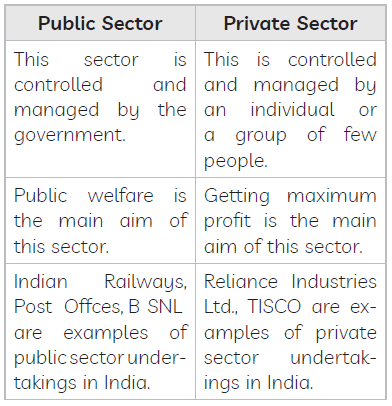
Question. Why is the organised sector preferred by employees? Explain.
Ans. The organised sector is preferred by employees because –
(1). Assured availability of work – Organised sector ensures year-long availability of work and continuous livelihood support. Employees in the unorganised sector don’t have continuous work available.
(2) Job security – Workers in the organised sector enjoy security of employment. They are expected to work only a fixed number of hours. They are paid overtime otherwise. They cannot be removed withot any proper reason.
(3) Added benefits and incentives – Employees of the organised sector get paid leave, provident fund and gratuity while employees of the unorganised sector do not have any such guarantee
Question. Suggest any three ways to save workers of unorganised sector from exploitation.
Ans. Measures to save employees of the unorganised sector from exploitation are :
(1) Workers of the unorganised sector in rural areas are mostly farmers. They can be supported through adequate facility for timely delivery of seeds, agricultural inputs, credit, storage facilities and marketing outlets.
(2) Workers involved in small scale industries also need support for procuring more raw material. This shall provide them with regular wages.
(3) These workers should be educated, skilled and made aware of their human and labour rights to protect them from social discrimination and exploitation to the hands of their employers.
Long Answer Type Questions
Question. “The declining share of agriculture in the gross domestic product (GDP) is a matter of serious concern in India.” Support the statement.
Ans. The declining share of agriculture in the gross domestic product (GDP) is a matter of serious concern in India because:
(1) Indian farmers are facing challenge from international competitors.
(2) The government is reducing investment in the agricultural sector, especially the irrigation sector.
(3) Subsidy in fertilisers has decreased, leading to a rise in the cost of production.
(4) There has been a reduction in import duties on agricultural products. So cheap agricultural products are coming from abroad.
(5) Farmers are withdrawing their investment in the agriculture industry, causing a downfall in employments.
Question. Explain how: (A) Public sector contributes to the economic development of a nation
(B) Government contributes towards helping private sector grow
Ans. (A) In many ways does the public sector contributes to the economic development of our nation. Let’s go through some of the ways below in detail:
(1) Public sector promotes rapid economic development through creation and expression of infrastructure.
(2) t generates financial resources for development
(3) It creates employment opportunities and ensures equality of income, wealth and thus a balanced regional development.
(4) It encourages the development of small, medium and cottage industries, and ensures easy availability of goods at moderate rates.
(5) Contributes to community development i.e., to the Human Development Index (HDI) via health and educational services. (Any 4 points will award full marks)
(B) There are some activities, which the government has to support for the private sector to continue their production or business. For example, selling electricity at the cost of generation may push up the costs of production of industries. Many units, especially small-scale units, might have to shut down. Government steps in by producing and supplying electricity at rates which these industries can afford. Government has to bear part of the cost. Similarly, the government in India buys wheat and rice from farmers at a ‘fair price’. This it stores in its godowns and sells at a lower price to consumers through ration shops. In this way, the government supports both farmers and consumers.
Question. ‘There are a large number of activities which are the primary responsibility of the government.’ Do you agree to it? Support your view with arguments.
Ans. Yes, I agree. For example,
(1) Providing health and education facilities for all is the prime responsibility of the governments at all levels.
(2) Running proper schools and providing quality education, particularly elementary education is the duty of the government. India’s size of illiterate population is one of the largest in the world.
(3) Similarly, half of India’s children are malnourished and a quarter of them are critically ill. Government also needs to pay attention to aspects of human development such as availability of safe drinking water, housing facilities, for the poor and food and nutrition.
(4) It is also the duty of the government to take care of the poorest and most ignored regions of the country through increased spending in such areas.
Question. Describe the employment conditions prevailing in the unorganised sector of the economy.
OR
“Workers are exploited in the unorganised sector.” Give reasons to support this statement.
Ans. Employment conditions in the unorganized sector:
(1) There are rule and regulations but these are not followed.
(2) Jobs are not secured.
(3) Jobs are low paid.
(4) No provisions for over time, holidays, sick leaves etc.
(5) People can be asked to leave without any reason.
(6) They are largely outside the control of government.
(7) Any other relevant point. Any five points to be described.
Question. Highlight any five benefits of the organised sector, with examples.
Ans. Benefits of the organised sector are as follows:
(1) Workers of the organised sector get regular and assured employment.
(2) Companies in the organised sector are registered/ enlisted under the government, and have to follow its rules and regulations which are mentioned in various laws such as Factories Act, Minimum Wages Act and Payment of Gratuity Act.
(3) Workers in the organised sectors enjoy privileges of job security and are expected to work only for a fixed number of hours.
(4) They also get several other benefits like paid leaves, provident fund, gratuity, etc.
(5) They also receive medical benefits, pension, etc.
(6) There is a provision for overtime payment, in case the workers do their duties after the fixed working hours.
Question. Show how tertiary sector has emerged as the largest producing sector in India.
Ans. Importance of Tertiary Sector :
(1) Basic services like hospitals, educational institutions, defence, and transport are the part of tertiary sector.
(2) Development of agriculture and industry leads to the development of services
(3) As the income level rises, tourism, shopping, private schools and professional training also expands. People start demanding more services this leads to the expansion of the tertiary sector.
(4) Information and communication technology also play an important role in this expansion.
(5) Large number of workers are engaged in this sector, as the demand for services grow.
Question. Do you think the classification of economic activities into primary, secondary and tertiary is useful? If yes, give reasons to support your view.
Ans. Yes, it is very useful because
(1) This classification gives us the total number of workers engaged in different sectors.
(2) This classification gives us the clarity of share of each sector in GDP
(3) This classification tells us which sectors is growing well and which one is lagging behind and accordingly measures can be taken to manage them.
(4) This classification tells us how these sectors are interdependent on each other.



